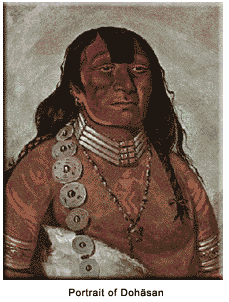 Dohäsan, born about 1805, was a chief of the Kiowa Apache. Little is recorded of his birth, childhood, or marriages. What is recorded is that he was the son of a chief named Dohá (Bluff), and a significant member of a long line of chiefs among the Kiowa. Dohäsan led the Kiowa for more than 30 years. He was celebrated as both a fierce warrior and an insightful administrator.
Dohäsan had many names. Whites called him Dohäsan, but his brethren called him Tohausen, Téh-tóot-sah, or Sierrito. Dohäsan’s name was hereditary; it translates as "Little Mountain," "Little Bluff," or "Top-of-the-Mountain." He was of the Kata band of Kiowa.
Massacre, dishonor, and new leadership
In late spring, 1833, principal Kiowa chief Dohate's¹ camp at Cutthroat Gap, near the head of Otter Creek in Indian Territory (Oklahoma), was attacked by the Osage Indians. Numerous Kiowa died, including women, children, and old men. A few warriors who had not previously departed with others to hunt buffalo or raid the Pawnee, were annihilated as well.
When members of the hunting party returned, they found the camp laid waste with headless bodies strewn about. The Osage had decapitated the dead Kiowa and put their heads in cooking pots. When they left, the Osage took two prisoners, several horses, and the Kiowas' sacred Tai-me medicine bundle². Following the massacre, the people held a tribal council, removed the dishonored Dohate as principal chief of the Kiowa, and named Dohäsan to replace him.
Treaties and Pax Romana
During his tenure as chief, Dohäsan signed several treaties, including, but not limited to, the following:
Dohäsan, born about 1805, was a chief of the Kiowa Apache. Little is recorded of his birth, childhood, or marriages. What is recorded is that he was the son of a chief named Dohá (Bluff), and a significant member of a long line of chiefs among the Kiowa. Dohäsan led the Kiowa for more than 30 years. He was celebrated as both a fierce warrior and an insightful administrator.
Dohäsan had many names. Whites called him Dohäsan, but his brethren called him Tohausen, Téh-tóot-sah, or Sierrito. Dohäsan’s name was hereditary; it translates as "Little Mountain," "Little Bluff," or "Top-of-the-Mountain." He was of the Kata band of Kiowa.
Massacre, dishonor, and new leadership
In late spring, 1833, principal Kiowa chief Dohate's¹ camp at Cutthroat Gap, near the head of Otter Creek in Indian Territory (Oklahoma), was attacked by the Osage Indians. Numerous Kiowa died, including women, children, and old men. A few warriors who had not previously departed with others to hunt buffalo or raid the Pawnee, were annihilated as well.
When members of the hunting party returned, they found the camp laid waste with headless bodies strewn about. The Osage had decapitated the dead Kiowa and put their heads in cooking pots. When they left, the Osage took two prisoners, several horses, and the Kiowas' sacred Tai-me medicine bundle². Following the massacre, the people held a tribal council, removed the dishonored Dohate as principal chief of the Kiowa, and named Dohäsan to replace him.
Treaties and Pax Romana
During his tenure as chief, Dohäsan signed several treaties, including, but not limited to, the following:
The Fort Gibson Treaty, signed in May 1837, by which the United States government sought to
The Fort Atkinson Treaty of July 27, 1852, which
The Little Arkansas Treaty of October 1865, which
Despite signing several treaties, Dohäsan held little regard for the white man and his agreements. He believed that Indians should fight to retain their lands and rights as a free people. Dohäsan vigorously protested confinement to a reservation, and asserted that the Kiowas owned all the land from the North Platte River in Wyoming to the upper Texas Panhandle and needed room to roam. Raids and war parties Dohäsan and his followers frequented the Texas Panhandle, particularly the Canadian River valley. In the summer of 1851, he led a war party against the Pawnees near the head of Medicine Lodge Creek in Kansas. In 1857, he successfully led his warriors out of an ambush by the Mexican military at Hueco Tanks near El Paso. In 1859, Dohäsan received a gift of an old army ambulance wagon as a goodwill gesture by Major John Sedgwick and his troops. Dohäsan never learned how to drive the wagon, so he had young braves ride and guide the team of horses. Attack at Adobe Walls In November 1864, during a winter campaign against the Kiowa nation, Colonel Christopher H. (Kit) Carson's force of more than 300 soldiers attacked and burned a camp of 150 lodges and supplies of dried meats, berries, and buffalo robes, at the first battle of Adobe Walls on the Canadian River, Texas. Dohäsan and other warriors succeeded in repulsing the attack, showing great bravery against superior numbers. Luckily, the old chief managed to warn the villages farther down the river. During the engagement, Dohäsan lost his prized wagon to the army forces. In 1865, the Kiowa Apache officially became part of the Cheyenne according to terms of the Treaty of the Little Arkansas River. Legacy of a great man’s death In early 1866, Dohäsan died at age 61, not in battle, but at the hands of a private citizen. His death created a leadership dispute among potential successors, which also exerted a destabilizing effect on the relationship between the Kiowa and white America, setting off an increase of Kiowa hostilities. The old freedom fighter's name was bestowed upon his son, also a distinguished warrior.